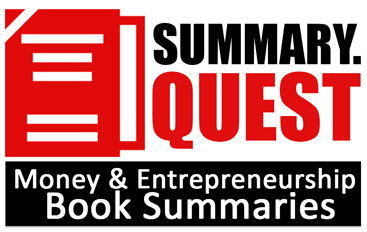Ever feel overwhelmed by juggling too much and struggling to achieve flow state? Well, meet Brandi Olson and her solution, “Real Flow: Break the Burnout Cycle and Unlock High Performance in the New World of Work”. In this blog-post, you’ll learn strategies to navigate chaos, redefine your definition of success, achieve flow state, and lead a team to high performance. Whether you’re a leader steering an organization or an entrepreneur and individual seeking personal growth, these tactics are applicable. Let’s break free from the chaos, prioritize well-being, and unlock lasting success together!
Key Idea No. 1: Signs of a Flooded Workplace

Navigating an organization is a lot like steering a boat down a river. When the waters are calm, everything falls into place – people effortlessly achieve goals, work feels satisfying, and innovative ideas materialize into real accomplishments. Collaboration becomes second nature, and victories start stacking up.
Yet, when a flood hits, it’s a different story. The pace becomes overwhelming, tasks pile up, and completion takes longer than expected. You’re putting in effort, but it feels like the river is in control, not you. Fast-moving waters don’t always translate to swift progress. In the chaos, it’s easy to mistake busyness for productivity, especially in a culture that often associates hard work with effectiveness. The truth is, being caught in a flood means spending more time managing chaos than moving forward.
In order to achieve flow state, it is essential to differentiate between flow and flood. However, it might not be easy to distinguish between a smooth flow and a flood, especially if you’ve been swimming in organizational chaos for a while. Here are some signs to help you recognize the problem:

- Ever tried scheduling a meeting? As the boss, you can gather everyone quickly, but for others, it’s a scheduling nightmare. It takes ages to set up a simple half-hour conversation, and chances are key people won’t make it.
- You can’t slow down enough to collaborate for half a day, so you settle for an hour every other week.
- Your front-line team struggles to see how their work contributes to the big strategic goals. It’s like they’re working in isolation.
- You find yourself thinking, “Everything feels out of control. If only we had a process that everyone had to follow to get things done.”
- Emails dominate your communication. With no time for face-to-face discussions, you resort to the “send an email, solve the problem” approach.
- Documents replace conversations. Important decisions are buried in document dumps, leaving everyone to figure things out on their own.
- Your calendar is packed with meetings, but the actual work never seems to get done.
- Everything seems on track until it’s suddenly a crisis. No one admits things aren’t going well until it’s too late, and then the blame game begins.
Key Idea No. 2: The Ugly Truth

Imagine being handed a jug of water and asked to transport it carefully from one point to another in a room. It’s challenging but doable, right? Now, picture the same amount of water divided into four cups. Your new mission: carry those cups across the room without spilling a drop. The task suddenly feels trickier, even though it’s the same water. It’s a different ball game.
Now, let’s say you successfully transported the cups. I’m impressed and want to give you an exciting new creative project. However, this time, it’s not just cups – you have to handle three cups and a strangely shaped vase. The job gets trickier, and no matter how good you are at carrying water, you might spill some, your speed could take a hit, and you might feel stressed.
Many of us attempt multitasking, thinking we can divide our time into percentages. But our brains don’t work that way. Research shows the brain can’t perform two conscious tasks simultaneously. So, even if you think you’re multitasking, your focus is fractured, leading to burnout, wasted time, and lower-quality work.

Here are some steps to rethink multitasking in your work routine:
- Audit Your Workload: Evaluate your current workload. Are you juggling too many tasks? Identify tasks that can be streamlined or delegated.
- Implement Flow Principles: Prioritize tasks, allowing yourself and your team to focus on one thing at a time. Adjust deadlines or reshuffle priorities if needed.
- Communicate Effectively: Context switching has a cost. Enhance communication within your team to minimize unnecessary switches and reduce the mental load.
- Embrace Simplicity: opt for straightforward approaches to tasks rather than getting lost in intricate plans.
- Rethink Capacity Management: Humans aren’t divisible into parts. When planning projects, consider the holistic involvement of team members.
- Encourage Rest and Recovery: Constant multitasking takes a toll on well-being. Encourage breaks within your team. A rested mind is more efficient and creative.
By taking these steps, you’re actively working towards a more effective and sustainable work environment. It’s not about doing less; it’s about doing things differently and aligning with the natural functioning of the human brain.
Key Idea No. 3: Business Paradigms
Picture this: a bunch of MBA students diving headfirst into a mission to set up a lemonade stand for a class project. Armed with business plans and profit forecasts, they approached it like a finely tuned machine. But, surprise, surprise! Despite their detailed planning, the stand was a bit of a flop.

Now, compare that to the lemonade stand run by an eight-year-old neighbor. Sure, she didn’t have the strategic brilliance of MBA students, but whenever she set up shop, it was like a cash magnet. The secret sauce? It wasn’t just about the lemonade; it was the heartwarming chats with a cute kid that reeled people in.

These two lemonade gigs showcase different business models. The MBA crew was all about the numbers, treating the stand like a machine to understand and duplicate. Meanwhile, the kid intuitively made her stand a web of relationships, interactions, and, of course, ingredients.
Most companies look like well-oiled machines on paper, with departments neatly outlined. But the real enchantment lies in the connections between these parts – the relationships, chats, and patterns that pop up.
The problem crops up when organizations stick to a machine mindset, focusing on parts and neglecting relationships. This often results in burnout as folks navigate constant context-switching without thinking about the bigger picture.
Think of an organizational ecosystem like a rainforest. It can be organized and healthy, chaotic and weak, or somewhere in between. The goal? Aim for a lively ecosystem, where interactions create more than the sum of its parts, fostering innovation and adaptability.
To stop the flood of organizational multitasking, leaders should step into their role as ecosystem leaders. Say goodbye to the illusions of the machine paradigm. Shifting mindsets and leadership styles might be a challenge, but it’s essential for a flourishing, flexible, and inventive organizational ecosystem. It’s time to be a leader in the real world, recognizing that true success comes from the power of interactions and relationships within the organization.
The main point? Leaders need to get a grip on the existing ecosystem in their organizations. It’s not about starting from scratch; it’s about acknowledging the reality that’s already there.
But wait, there’s more. It’s not just about understanding; it’s about taking action. Boost collaboration by getting different departments to chat. Embrace change by realizing it’s always around the corner. Drive innovation by embracing the unexpected outcomes that pop up in a well-nurtured ecosystem.
Key Idea No. 4: How to Achieve Flow State?
To achieve that sweet state of flow, start by visualizing everything. Picture your tasks like pieces of a puzzle – you can’t lead what you can’t see, right? So, let’s break down the steps to make this happen.
- Visualize Your Work: Stick each project on a note and organize them into three categories “To Do,” “Doing,” and “Done.” Spend a week updating the board – move completed items to “Done” and add new ones to “Doing.” This simple step reveals how work flows or floods in your organization. Why does this matter? Well, most people have no clue how their daily grind contributes to the bigger picture. A study found that less than a third of employees knew how their work connected to their company’s goals. It’s like working in separate boats without knowing where others are headed.
- Identify Obstacles: Making your work visible is a start, and you might notice it’s not flowing as smoothly as you’d like. Two common reasons? First, your goals are unclear. Vague goals waste time and energy. Be specific – like “increase new client engagements by 10%.” Second, your projects are too darn big. Think of them like big barges in a river – slow and prone to blockages. Break them down into smaller, manageable parts.
- Limit Your Work in Progress (WIP): Now, let’s talk juggling cups. You can only handle so many at once. Apply the same principle to your work. Set a WIP limit – a boundary around the number of ongoing tasks. Finish one before starting another. This isn’t just for you; it’s for your whole fleet of boats (organization). Experiment to find that sweet spot.
- Make Your Work Visible: Why keep your plans and projects hidden? Making your work visible is like turning on a light in a dark room. It’s about creating transparency for yourself and everyone around you. Stick to that flow board; update it regularly.
- Take Action: Now that you’ve visualized your work, identified obstacles, set WIP limits, and made everything visible – it’s time to take action. Execute your plans with clarity, keep an eye on that flow board, and adapt as needed. When you see patterns in the flow, you’ll be better prepared to anticipate and navigate the future.
In a nutshell, achieving flow is not a distant dream; it’s a series of actionable steps. So, grab that flow board, break out the sticky notes, and let’s set sail towards a more productive and efficient work environment.
Key Idea No. 5: Dangers of Best Practices

Life is a constant quest for the best, whether it’s the perfect deal, the right answer, or the ideal dishwasher. Take, for instance, author’s mission to find the ultimate dishwasher. Instead of a quick buy, she dove into a research rabbit hole – Consumer Reports, Google reviews, and whatnot.
The flaw in this “best” approach hit hard. Amid a chaotic work season and virtual school for the kids, months passed. She found herself stuck washing dishes for a family of five. The irony struck during a presentation on flow, where she boldly crossed out the word “best.” The quest for the best dishwasher had caused a bigger issue than the dishwasher breaking in the first place.
Universal best practices are a myth, be it in choosing appliances or running organizations. Leaders often seek magic solutions from consultants on team organization, strategy, and effectiveness.
But let’s get real – best practices are a mirage. They divert focus from actual progress to an endless search for an unattainable ideal. They push organizations into formulas crafted for someone else, ignoring their unique context.
The truth is, effective outcomes come from effective ways of working, grounded in reality. Your organization’s circumstances may be similar to others, but they’re not identical. Pursuing best practices wastes time and resources in a never-ending quest for something that doesn’t exist. Real progress comes from learning, experimenting, and adapting.
Now, let’s get practical with actionable steps:
- Take Small, Incremental Steps: Resist the urge to change everything overnight. Start with one area, make changes, learn, and apply those lessons elsewhere. Evolutionary change is your friend.
- Respect Current Roles: Avoid a radical overhaul of roles and responsibilities. Save major changes for a more stable period.
- Encourage Leadership at All Levels: Recognize that leadership can come from any level within your organization. Empower individuals to contribute, fostering a culture of leadership across the board.
In conclusion, Brandi Olson’s Real Flow offers a transformative approach to overcoming the challenges of organizational chaos and burnout.

As highlighted, Real Flow provides strategies to navigate flooded workplaces, reevaluate multitasking, understand organizational paradigms, achieve flow state, and steer clear of the pitfalls of blindly following best practices. Whether you’re a leader steering an organization or an individual seeking personal growth, these insights are invaluable. It’s time to break free from chaos, prioritize well-being, and unlock lasting success.
To delve deeper into these concepts and take actionable steps towards a more productive and efficient work environment, check out Real Flow by clicking here. Embrace the journey towards a flourishing, flexible, and inventive organizational ecosystem.

Leave a Reply